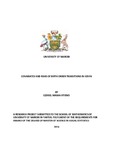| dc.description.abstract | The general objective of this study was an investigation of some of the key factors
determining transition between births among women of reproductive age in Kenya.
For this purpose, data from Kenya Demographic and Health Survey (KDHS) 2008-09
were used and a total of 4960 eligible women of child bearing age (women who had
had more than two children) selected for analysis.
Cox proportional hazards model was used to analyze factors responsible for
progression between births. In modeling spacing between births in a hazard function
as a time-to-event variable, the study also examined the risk of giving birth in
transition to higher orders given that women under study had already had lower
order births.
Among the seven explanatory variables of interest used in the analysis, age at first
birth, sex of preceding child, place of residence and wealth status were found to have
highly significant (p<0.001) impact on the dynamics of inter-birth transition. The
other remaining variables namely survival of preceding child (infant and child
mortality), region of residence (province) and education had insignificant impact.
Age at first birth was by far the most powerful predictor of timing between births in
this analysis. On the other hand transition between male births at lower orders was
found to be significantly longer than that between female births, indicating higher
parental investment in a boy child. However, in women of higher parity this
differential disappeared and subsequently became insignificant.
Although male births were less likely to be followed by a subsequent birth in the
lower birth orders, the absence of such a gender scenario in transition to higher
parities may have suggested that women in higher parities could already have had
the desired number of sons. However, the significantly higher probability of an index
child being followed by a subsequent live birth among older mothers (aged 40-49)
compared to younger ones needs to be read with caution since this age bracket is
normally characterized by onset of disappearance of a woman’s menses.
Findings of this study have generated recommendations which have both policy and
program relevance for policy makers as well as program managers in addressing
problems related to reproduction among women and in particular teenage mothers. | en_US |

